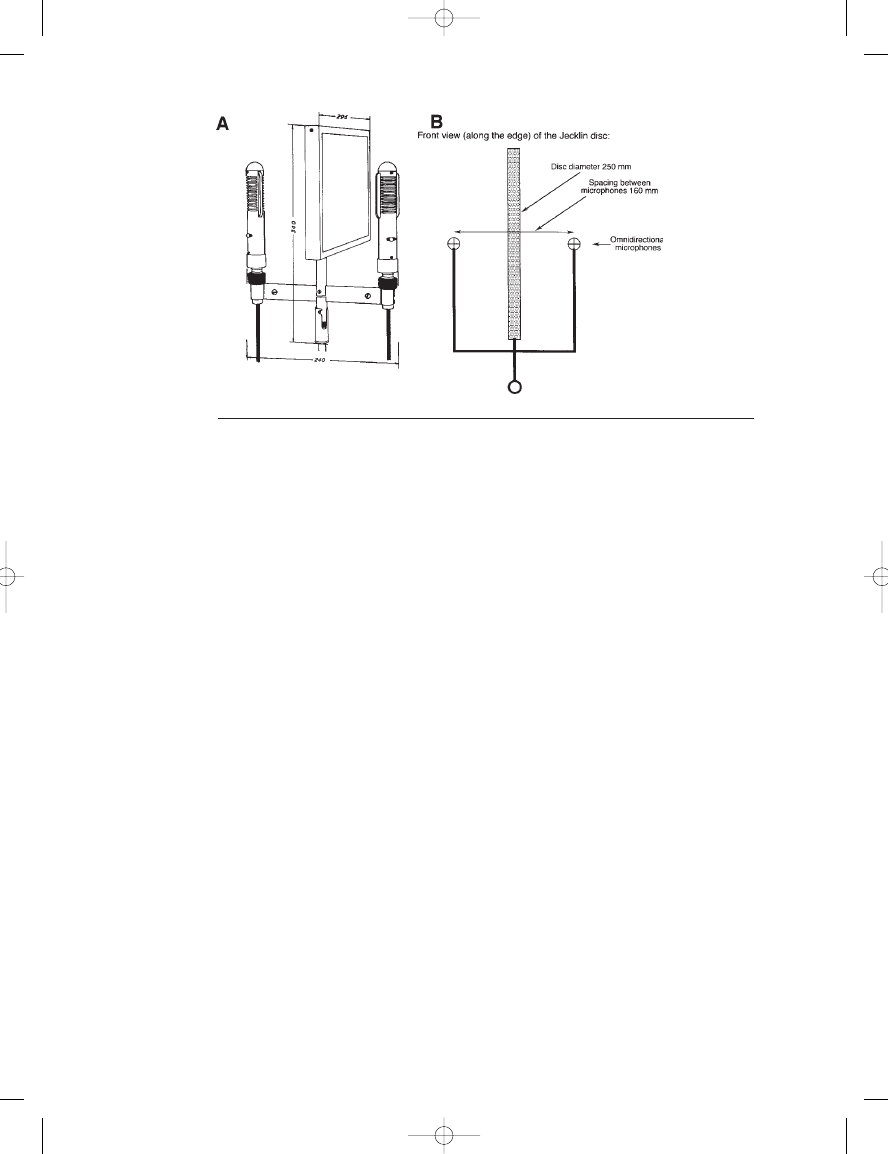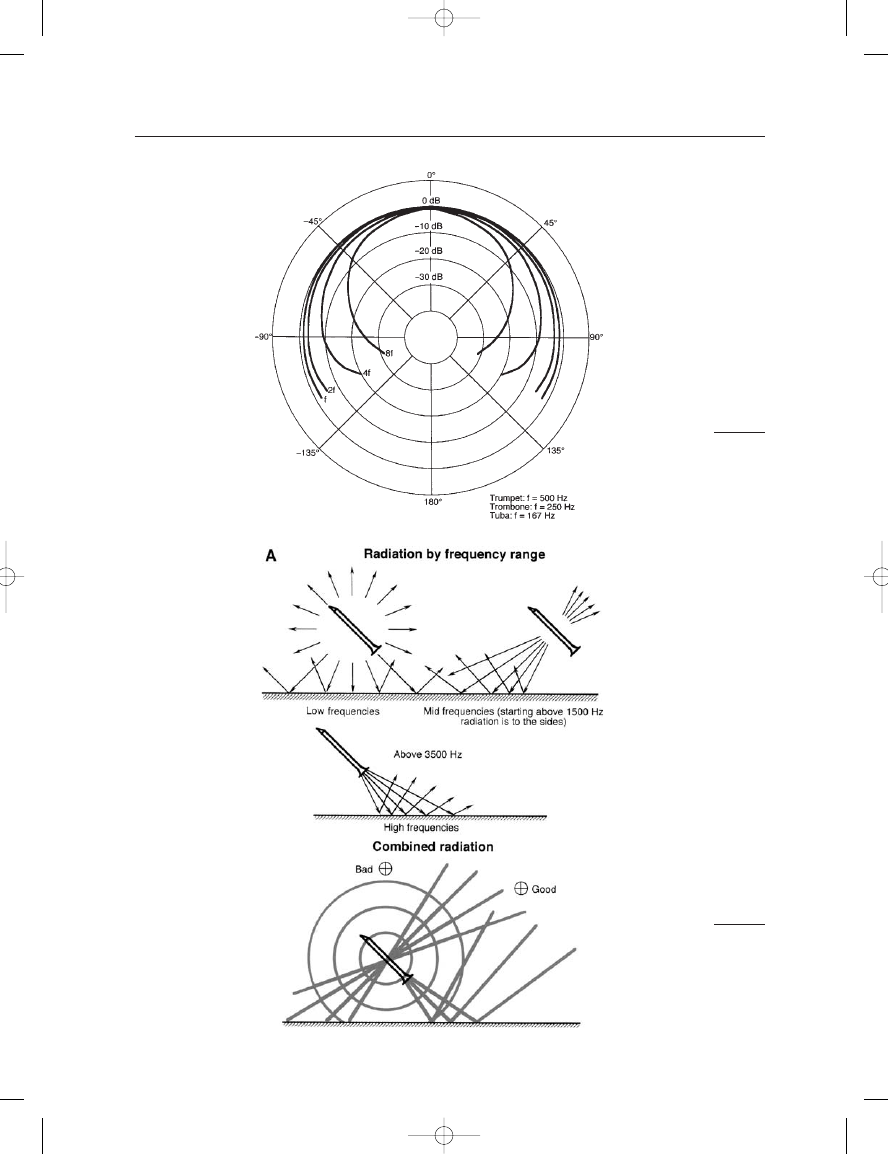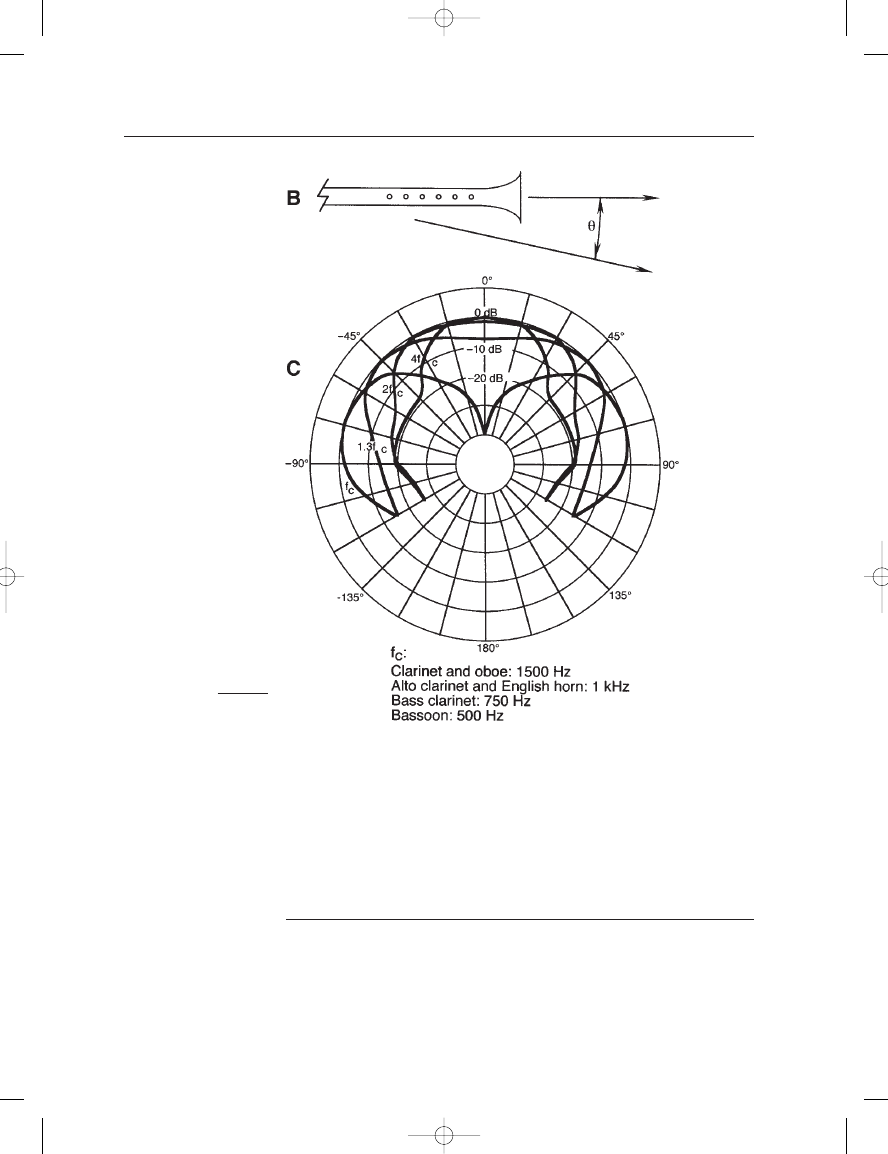ВУЗ: Казахская Национальная Академия Искусств им. Т. Жургенова
Категория: Книга
Дисциплина: Не указана
Добавлен: 03.02.2019
Просмотров: 17303
Скачиваний: 51

FIGURE 12–9
Use of baffles in stereo microphone pickup: Madsen’s application with a pair of ribbon microphones (A); details of the
Jecklin/OSS disc (B). (Figure at A courtesy of Journal of the Audio Engineering Society.)
Earg_12.qxd 14/9/04 2:51 PM Page 193

C
H
A
P
T
E
R
1
3
CLASSICAL STEREO
RECORDING TECHNIQUES
AND PRACTICE
INTRODUCTION
The topics covered in the previous two chapters form the basis for most
of our study in this chapter. We begin with a basic discussion of the
physical characteristics of musical instruments, moving on to a discus-
sion of case studies with reference recordings made by the author. We
progress from solo instruments, through chamber ensembles, to large
orchestral resources, with emphasis on the practical decisions that every
recording project requires. A final section deals with the adjustment of
room acoustical conditions to fit the recording project at hand.
Our recommendations for microphone placement throughout this
chapter remain the same whether you are recording direct-to-stereo or to
multitrack. The difference of course is that multitrack offers unlimited
opportunities to fix your mistakes later – rather than fixing them with
retakes during the sessions.
CLASSICAL RECORDING: ART FORM OR SCIENCE?
One of the first things an aspiring recording engineer learns is that the best
seats in a concert hall are not necessarily the best places to put micro-
phones. Those seats after all are where, by common agreement, orchestral
balance is judged to be ideal. Many of us have tried at least once to place
microphones at favored listening positions and found that the recording
sounded too reverberant, was dull at high frequencies, had insufficient
stereo stage width and, during quiet passages, was somewhat noisy.
Why should this be so? As we listen in a concert hall we are able to
distinguish direct sound cues (those that first reach our ears from the
stage), early reflections (those that help define the apparent stage width),
Earg_13.qxd 14/9/04 2:53 PM Page 194

and global reverberant cues (those that give an impression of the size of
the performance space). It is also an advantage that we can turn our heads
from side to side in order to further reinforce these cues and ultimately to
“zero in” on stage events and hear them in a familiar environment, even
in the presence of a reflected sound field that may be several times greater
in terms of acoustical power than the direct sound field itself.
A pair of stereo channels will have a difficult time duplicating this,
since so wide a range of desirable spatial cues cannot be reproduced as
such with only two loudspeakers. There are also performance constraints
in the consumer playback environment, be it one’s living room, automo-
bile, or portable Walkman.
As a result, modern classical recording practice remains what it has
always been: a close-up event with the principal microphones placed at
Row A and a playback effect in the home that seems to give the impres-
sion of being seated at Row J. How this is done will become clear as this
chapter progresses. First, we need to understand some of the acoustical
characteristics of musical instruments, including their directional aspects
and dynamic ranges.
SOME ACOUSTICAL PROPERTIES OF MUSICAL
INSTRUMENTS AND ENSEMBLES
In general, instruments radiate forward and upward relative to the
player’s seating position; however, all musicians appreciate the reflectiv-
ity of an uncarpeted performing area. At low frequencies all instruments
are essentially nondirectional. As we progress upward in frequency,
radiation becomes more pronounced along the bell axes of brass instru-
ments, while the directionality of woodwind instruments becomes fairly
complex. Figures 13–1 and 13–2 illustrate this.
String instruments radiate in a complex manner. At low frequencies
they are nearly omnidirectional, and at mid-frequencies there is a prefer-
ence for radiation perpendicular to the top plate, or “belly”, of the
instrument. At the highest frequencies the radiation pattern becomes
broad again as radiation is largely from the very small bridge of the
instrument. These general trends are shown in Figure 13–3.
The various keyboard and percussion instruments generally have
complex radiation characteristics due to their shapes and sizes and often
interact significantly with their environments.
Figure 13–4 shows the dynamic ranges characteristic of the major
instrumental groups. Within a given frequency range, the dynamic capa-
bility may be no more than 35 or 40 dB at most; however, over a large
frequency range the total dynamic capability can be considerable. The
French horn is probably most notable here, covering a range of about
65 dB from the lowest to highest frequency ranges, but limited to about
35 dB within any given frequency range. Of all orchestral instruments
the clarinet has the widest overall dynamic range within a given fre-
quency range, nearly 50 dB in the instrument’s middle range.
13: Classical Stereo Recording Techniques and Practice
195
Earg_13.qxd 14/9/04 2:53 PM Page 195

FIGURE 13–2
Directionality of
woodwind instruments:
basic characteristic (A);
off-axis measurement
graphs (B and C). (Data
after Benade, 1985.)
THE MICROPHONE BOOK
196
FIGURE 13–1
Polar response of brass
instruments along the bell
axis; values of f are given
for three brass instruments.
(Data after Benade, 1985.)
Earg_13.qxd 14/9/04 2:53 PM Page 196

The following discussions will largely detail the author’s experiences
in recording more than 280 compact discs. These are not the only
approaches, and the aspiring engineer is encouraged to experiment with
other approaches. References made to coincident pickup apply as well to
near-coincident pickup and to head-related techniques, as discussed in
preceding chapters.
RECORDING SOLO INSTRUMENTS
KEYBOARD INSTRUMENTS
One of the biggest problems in recording the piano may be the condition
of the instrument itself. Most good concert grand pianos are associated
with performance venues or schools of music and as such may be voiced
13: Classical Stereo Recording Techniques and Practice
197
FIGURE 13–2
Continued.
Earg_13.qxd 14/9/04 2:53 PM Page 197